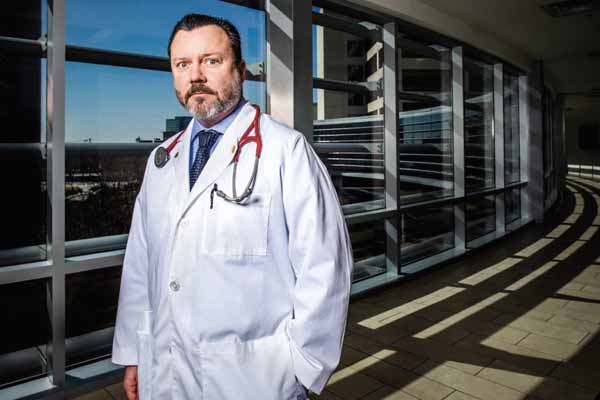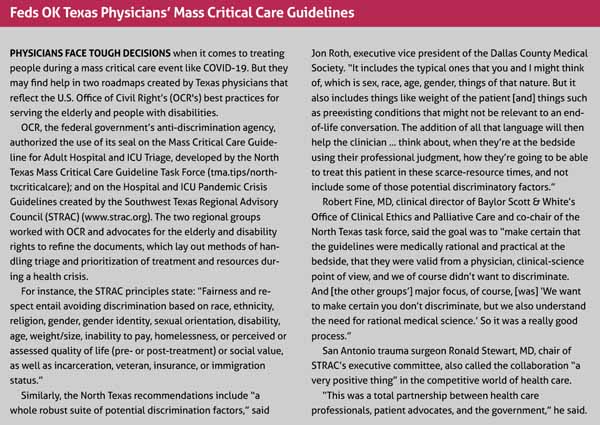
Challenges to Texas laws governing end-of-life care, whether through legislative rewrites or judicial override, are nothing new. The recent success of those challenges is.
In particular, two recent erosions have physicians like Houston palliative care specialist Mark Casanova, MD, chagrined and concerned about the future of doctors’ role in end-of-life treatment.
First, physicians in palliative care circles say a 2017 state law regulating in-hospital do-not-resuscitate (DNR) orders has become so bureaucratic and landmine-ridden that most physicians don’t even bother navigating its intricacies, instead taking the path of least resistance.
More recently, a successful court challenge threatens to upend the state’s medical ethics-committee process under the Texas Advance Directives Act (TADA), which allows physicians and patients the chance to resolve a dispute over whether end-of-life care is futile and causing the patient harm.
The developments “strip the essence of who we are as a physician and everything that lives outside of a textbook,” Dr. Casanova said. “All it does is say, ‘Read the menu, and follow the menu; read the textbook and follow this criteria. That’s all you’re supposed to do, doctor.’ And I think that … is becoming a bridge that is way too far. I do not personally feel that we in medicine should allow ourselves to be relegated as such.”
End-of-life discussions – and potential intrusions on physicians’ conscience – are becoming more prevalent than ever as the COVID-19 pandemic take over intensive care units, adds Robert Fine, MD, clinical director of Baylor Scott & White’s Office of Clinical Ethics and Palliative Care.
Which is why the Texas Medical Association continues to meet every challenge to TADA with a full-throated defense of the law, looking to maintain doctors’ right to “do no harm.”
The “culture of full code”
In 2017, the Texas Legislature passed Senate Bill 11, which regulated in-hospital DNR orders in Texas for the first time. The law introduced a set of criteria for what constitutes a valid DNR, laying out a maze of various methods for an attending physician to write a DNR order in compliance with written or oral directions from a patient or patient’s representative. (See “For End-of-Life Care, Fresh Challenges Begin,” March 2018 Texas Medicine, pages 24-29, www.texmed.org/endoflifecare.)
While SB 11 allowed physicians to still use their medical judgment when entering a DNR in certain situations, the law left other issues unclear, including potentially confusing permutations of criteria, and the possibility of physicians facing a misdemeanor for unlawfully entering, cancelling, or concealing a patient’s DNR order.
Physicians knew SB 11 would be a challenging adjustment.
Dr. Casanova, who’s been having end-of-life conversations for more than two decades, says the law has added “a bureaucratic, burdensome layer to something that is already traumatic, is already high-intensity emotionally, spiritually, psychologically, sometimes physically, for the patient,” he said.
“Many of these folks have had prior conversations [about end-of-life], so they know, ‘Wait a minute. I didn’t used to sign a form for this.’ Now, the powers that be ask me to have you sign this form – or get somebody to have you reiterate to me over the telephone, because your loved one’s in the ICU and you can’t visit – that you authorize us to enter a do-not-attempt-resuscitation order.
“It’s beyond awkward. It’s uncomfortable, and it’s an impediment to what is probably one of the most sacred and intense conversations one can have relating to the end of life.”
The DNR law also has led to more risk-averse decisionmaking by physicians, creating what Temple emergency physician Thomas Russell Jones, MD, describes as “more of a culture of full code” in hospitals – meaning physicians are defaulting to providing all resuscitation efforts.
“One of the things that I see is that probably physicians tend to be on the side of indecision. And indecision’s full code,” he said.
Rather than plunge into the pitfall-filled process of writing a valid DNR and risking a misstep, “it’s easier to deal with full code than it is to try to get involved and ask the questions and explain what’s going to happen, and say, ‘Look, if we do CPR, we’re probably going to break your ribs. It’s just almost unavoidable, because at 93, your ribs are going to be brittle, and in order to do adequate chest compressions, we’re probably going to break them.’
“I’m not trying to say that doctors should try to scare people for a code status, but that’s one factor that’s probably very obvious that needs to be explored and discussed,” Dr. Jones added.
Texas Right to Life, the advocacy group that helped drive SB 11 and other recent challenges to TADA, did not return messages seeking comment.

Ethics committee process hangs in the balance
On the other hand, the latest hit to Texas physicians’ exercise of medical conscience came when the U.S. Supreme Court decided not to take up an appeal in Cook Children’s Medical Center v. T.L.
That lawsuit, brought by the mother of a young child, identified as T.L. in court documents, attacked TADA’s medical ethics committee process. The dispute resolution system covers situations in which a physician believes life-sustaining treatment would exacerbate or extend a patient’s suffering, and then refuses to start or continue that treatment contrary to the wishes of the patient or someone else making the patient’s health care decisions. If the panel agrees with the physician, a 10-day period to transfer the patient kicks in. After that, the physician is immune from civil or criminal liability for withdrawing treatment. (See “End of Life Challenge Takes a New Turn,” November 2020 Texas Medicine, pages 43-47, www.texmed.org/eolchallenge.)
Last year, the Texas Second Court of Appeals sided with the mother, based on what many in medicine consider a dangerous rationale. The appeals court ruled that private physicians and hospitals deciding whether to withdraw life-sustaining treatment are performing “state action,” meaning they must follow the Fourteenth Amendment of the U.S. Constitution, which prohibits states from depriving a person of life without due process. The court decided TADA doesn’t provide that due process.
That decision stuck after both the Texas Supreme Court and the U.S. Supreme Court declined to review it. As it had in Texas courts, TMA submitted a friend-of-the-court brief to the high court refuting such an interpretation.
“By classifying this private hospital as a state actor, the court created an ongoing role for itself – and future state and federal courts – in second-guessing these most private end-of-life decisions,” said TMA’s brief, which also included signatures from the Texas Alliance for Patient Access, Texas Alliance for Life, the Texas Catholic Conference of Bishops (TCCB), and the Coalition of Texans With Disabilities, among others.
“Classifying private hospitals and doctors as state actors reduces them for constitutional purposes to cogs in the machine of the state, leaving no room for independent medical ethics or diversity of individual conscience,” the brief added.
A Supreme Court filing for the child presented the argument that the ethics-committee law “allows hospitals to end patients’ lives without allowing them notice and opportunity to be heard on the value of their life.” It said the ethics-committee law doesn’t provide “adequate due process protections against the conflict of interest inherently present when the treating physician’s decision is reviewed by the hospital ethics committee to whom the physician has direct financial ties and which itself is made up of individuals with ties to the hospital.”
The filing also said the law doesn’t supply a standard for determining “the propriety” of either life-sustaining treatment or “the physician’s refusal to honor a parent’s health care decision on behalf of her child.”
The appeals court decision puzzled many physicians, including Dr. Casanova.
“I was just trying to wrap my head how they went from a treating physician caring for a very unfortunate little girl to being defined as a state actor. If you’re sitting across from me in person right now, you’d see I have a quizzical look on my face. Because I can’t reconcile that. I just don’t understand how they made that jump and what they mean by that.”
The Catholic bishops organization has been one of medicine’s staunchest allies in trying to preserve TADA as it now exists. Jennifer Carr Allmon, TCCB’s executive director, says TADA balances the personal right of conscience of both patients and physicians.
“We respect and understand patients’ desire to seek every possible alternative and way to save their loved ones’ life. And we recognize that in most of these cases, that’s what goes on, and the family is really seeking to protect their loved one. And we honor that. We think that’s an appropriate thing for a family to want to do. It’s part of family life. But we also believe that fundamentally, the structure of the law provides an avenue for that resolution.”
TMA General Counsel Rocky Wilcox says medicine and other stakeholders are “considering our options” in the wake of the Cook Children’s decision.
Protecting patients
With a pandemic in full swing, Baylor Scott & White’s palliative care teams have never been busier trying to support patients, families, and clinicians through the increased burdens of end-of-life discussions, says Dr. Fine, who helped write TADA back in the 1990s. He’s never seen critical care teams under more pressure. And the result, he says, is that the ethics-committee law is too much for many physicians to deal with.
“My perception is most doctors are just saying, ‘I don’t have the time to do this, so if the family’s demanding I maintain treatment, I’m just going to keep maintaining treatment. Even though I believe it is not going to work in terms of survival to discharge, or survival to a functional status that the patient would want or could enjoy.’”
As a result, Dr. Fine says the DNR law ethically “creates a huge jeopardy for the patient,” because that may lock both patient and physician into the physical and moral stresses of futile CPR.
“If you tell me you want to be full code now, neither I nor your family could ever change that, and you could wind up being brutalized at the end of your life – not just one time or two times, but five or 10 times in the span of the last days of your life. The law says because you once requested CPR, we must always attempt it – no matter how your circumstances change – and we must attempt it time after time,” Dr. Fine said.
“So doctors and nurses complain on [patients’] behalf as we put them through this procedure. That comes back to the moral distress. Doctors want to save lives when they can. They always want to prevent suffering as best they can as well, and being subjected to CPR over and over when it cannot lead to survival, to hospital discharge, is a particularly cruel form of suffering.”
Tex Med. 2020;117(3):30-34
March 2021 Texas Medicine Contents
Texas Medicine Main Page